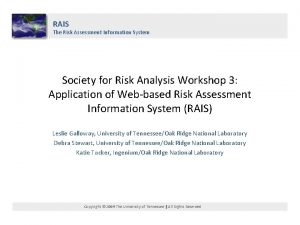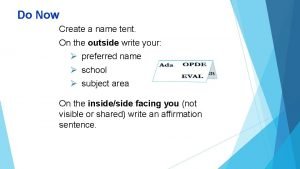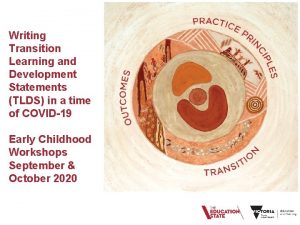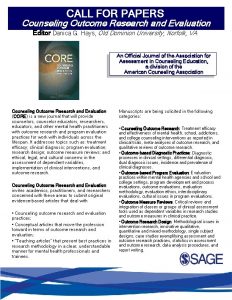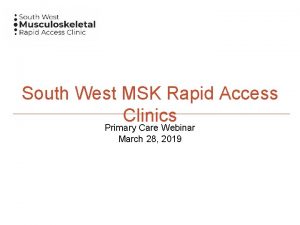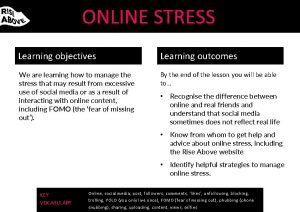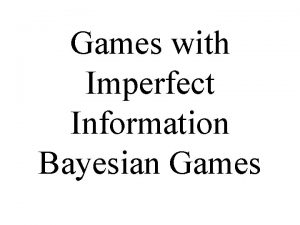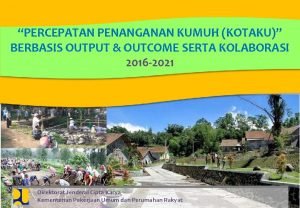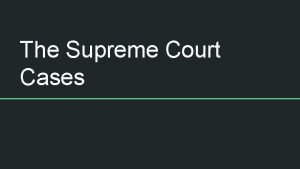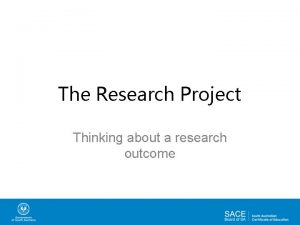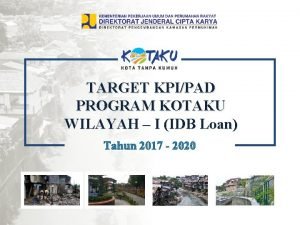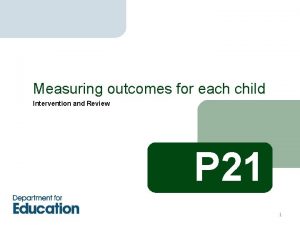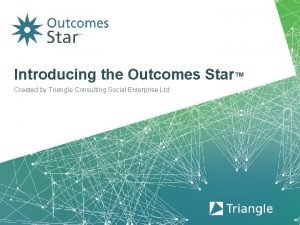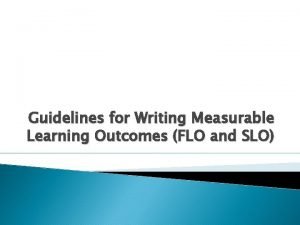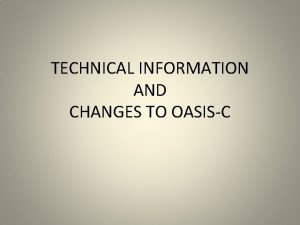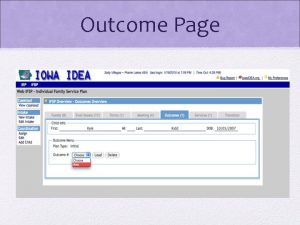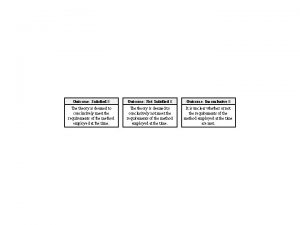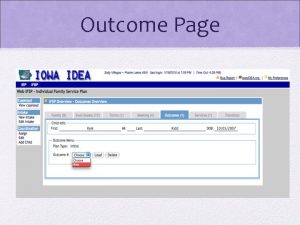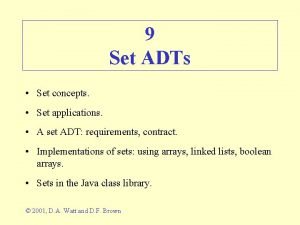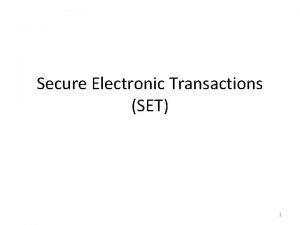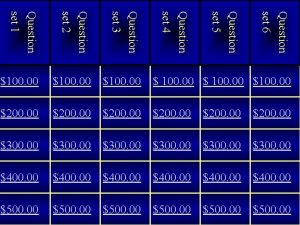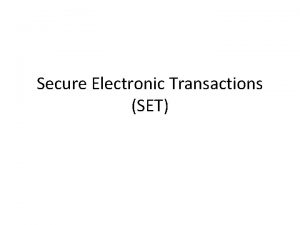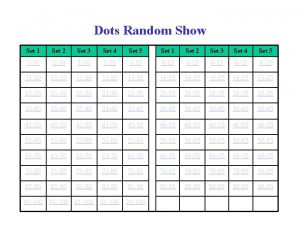OASISC Outcome and Assessment Information Set Outcome and













































- Slides: 45

OASIS-C Outcome and Assessment Information Set

Outcome and Assessment Information Set (OASIS) OASIS is a group of standard data elements developed, tested, and refined over the past two decades through research and demonstration program funded primarily by the Centers for Medicare and Medicaid Services (CMS). OASIS data elements are designed to enable systematic comparative measurement of home health care patient outcomes at two points in time.

OASIS Outcome measures are the basis for outcomebased quality improvement (QBQI) efforts that home health agencies can employ to assess and improve the quality of care they provide to patients. In 1999, Medicare certified HHAs began collecting and submitting OASIS data related to adults (18 years and older) and nonmaternity patients receiving skilled services with Medicare or Medicaid as the payer source.

OASIS The comprehensive assessment and OASIS data set requirements apply to Medicare certified home health agencies and to Medicaid home health providers. OASIS is not collected on patients under the age of 18, maternity patients, patients receiving personal care only, or patients receiving a single visit in a quality episode.

Comprehensive Assessment The Start of Care (SOC) comprehensive assessment must be completed on or within 5 calendar days after the SOC date and in compliance with agency policies. The initial assessment must be completed by an RN, if the nursing orders exist at the SOC, and by appropriate, qualified therapist, if no nursing orders exist.

Comprehensive Assessment Only one individual completes the comprehensive assessment. Even if two disciplines are seeing the patient at the time a comprehensive assessment is due, while care coordination and consultation are needed, only one individual actually completes and records the assessment. When both RN/PT/SLP are ordered on the initial referral, the RN must complete the SOC comprehensive assessment.

Start of Care (SOC) The SOC date (M 0030) is the date of the first billable visit and is maintained as the SOC until the patient is discharged. Even if a new service enters the case during the episode of care, the SOC date is still the first billable visit during the episode of care.

Resumption of Care It is not required that the Resumption of Care (ROC) comprehensive assessment be completed on the first visit following the patient’s discharge from an qualifying inpatient stay. However, the ROC must be completed within 48 hours of discharge following a qualifying inpatient stay or within 48 hours of knowledge of a qualifying stay in an inpatient facility. If the Agency becomes knowledgeable about the inpatient stay through an agency staff that is not qualified to conduct an assessment, the agency must send a qualified clinician to conduct a visit and complete both the transfer and the ROC.

Resumption of Care At the ROC, there is no regulatory language allowing the ROC to be delayed by physician order, greater than 48 hours from the inpatient facility discharge. The agency should make every effort to complete the ROC assessment within the 48 hours from the qualifying inpatient discharge. If the patient refuses or isn’t available, the ROC should be completed as soon as possible.

Recertification (follow-up) Assessment A Medicare/Medicaid skilled-care adult patient who remains on service at a HHA into a subsequent episode requires a follow-up comprehensive assessment during the last 5 days of each 60 day period until discharged. If a patient is hospitalized and returns to the HHA during the last 5 days of an episode, the Resumption of Care (ROC) assessment should be completed fulfilling both the ROC and recertification requirements.

Recertification vs Resumption of Care A patient was discharged from an inpatient facility on day 53, would the HHA be required to do a recertification or resumption of care? The HHA will be required to do a ROC on day 54 or 55. A ROC has to be completed within 48 hours of an qualifying inpatient stay. A patient was discharged on day 54 or 55, would the HHA be required to do a recertification or resumption of care? The HHA will be required to do a ROC no later than day 56 or 57.

Day of Assessment Home care visits can occur at any time of the day and to standardize the timeframe for assessment data, the “day of assessment” refers to the 24 hour period directly preceding the assessment visit, plus the time the clinician is in the home conducting the assessment. The standard definition ensures that fluctuations in the patient status that may occur at particular times during the day can be considered in determining the patient’s ability and status, regardless of the time of day of the visit.

Drug Regimen Review A drug regimen review should be conducted on all medications including prescribed and over the counter administered by any route (oral, topical, inhalant, pump, and injection). All drugs are not considered “potential clinical significant medication issues. ” It includes serious drug-drug, drug-food, and drug-disease interactions and are those that “pose an actual or potential threat to patient health and safety. ” Not all clinical side effects are considered “potential clinically significant medication issues. ” A side effect would be considered a “potential clinically significant medication issues. ” if it “poses an actual or potential threat to patient health and safety. ” The determination of whether a medication issue meets this threshold should be based on the clinician’s judgment in conjunction with agency guidelines and established standards for evaluating drug reactions and interactions.

Drug Regimen Review Collaboration in which the assessing clinician evaluates patient status and another clinician assists with review of the medication list does not violate the requirement that the comprehensive patient assessment is the responsibility of and must be completed by one clinician. RN, PT, OT, PT and the pharmacist can collaborate with the assessing clinician. However, the agency policy and practice determines how the pharmacist participates in the drug review and how it is to be documented.

Drug Regimen Review The physician or the physician designee must be contacted within one calendar day to resolve clinically significant medication issues including reconciliation. A “Yes” can be selected if the two way communication AND reconciliation (or plan to resolve the problem) must be completed by the end of the next calendar day

Drug Regimen Review If a medication related problem is identified and resolved by the agency staff by the time the assessment is completed, the problem does not need to be reported as an existing clinically significant problem.

Drug Education If agency staff, other than the clinician responsible for completing the SOC/ROC OASIS, provided education to the patient/caregiver on high-risk medications, this information must be communicated to the clinician responsible for the SOC/ROC OASIS assessment so that the appropriate response for M 2010 may be selected. This collaboration does not violate the requirement that the comprehensive patient assessment is the responsibility of, and ultimately must be completed by one clinician.

Medication Follow-up Medication follow-up is only collected at the SOC and ROC. The item must be answered within the timeframe allowed at SOC/ROC to ensure compliance with the Condition of Participation regarding the completion of the comprehensive assessment. If a medication issue is identified, the communication and reconciliation must occur within one calendar day of identification and before the end of the allowed timeframe in order to answer “yes. ”

Medication Follow-up For process measure items reporting communication to and from the physician or physician designee, such as M 1510 or M 2002, communication can be directly to and from the physician, or indirectly through physician’s office staff on behalf of the physician in accordance with the legal scope of practice. This is different from the process measure M 2250 for physician orders and must come directly from those physicians as defined in M 2250 item set.

At home Therapies (1030) At home therapies refer to intravenous and infusion therapy, parenteral nutrition, or enteral nutrition that the patient received at home (place of residence). Intravenous means administration via IV line or IV catheter. Infusion therapy means via central line, subcutaneous infusion, epidural infusion, intrathecal infusion, or insulin pump. Parenteral nutrition means TPN or lipids. Enteral nutrition means administration via G-tube, J-tube, or PEG-tube

At home Therapies Hemodialysis and peritoneal dialysis in the home is considered as infusion therapy. When a patient has a G-tube, J-tube, or PEG-tube and it is only utilized for the administration of medication or water for hydration, it is not considered as nutrition. Any oral electrolyte solutions such as Pedialyte that are administered to prevent dehydration are not considered as nutrition.

ADLs Most of the items under the ADLs component identifies the patient’s ABILITY, not necessarily actual performance. “Willingness” and “compliance” are not the focus of these items. These items address the patient’s ability to safely perform a task, given the current physical and mental/emotional/cognitive status, activities permitted, and environment. The patient must be reviewed from a holistic perspective in assessing ability to perform ADLs.

ADLs When a patient’s ability varies on the day of assessment, the clinician reports what was true for a majority of the time. If a patient’s ability varies among the tasks in a single OASIS item, select the response that represent the patient’s status in the majority of the tasks.

ADLs When scoring the OASIS, clinicians should avoid applying “always”, “never”, or “automatically “ rules. Each item, the response options contained in the item, and additional available guidance should be reviewed in order that the most accurate response can be selected.

Standardized Tools For items M 1240, Pain Assessment, M 1730, Depression Screening, and M 1910 Fall Risk Assessment, a standardized tool must be used. A standardized tool is one that has been scientifically tested and validated. A standardized tool includes a standard response scale and must be appropriately administered based on established instructions.

Standardized Tools To meet the need of pain assessment, the depression screen or the multi-factor fall risk assessment referenced in the OASIS, an agency may use a standardized tool from any organization able to effectively develop, test, and validate the tool for use on a population similar to that of the patient(s) being assessed.

Living Arrangement The intent of M 1100 is for the assessing clinician to determine whether the patient is living alone or with others and the availability of caregiver(s) (other than home health agency staff) to provide inperson assistance. To answer this item set, you must first determine the living arrangement (whether the person lives alone, in a home with others, or in a congregate setting), and secondly, determine the availability of assistance (how frequently caregiver(s) are in the home and available to provide assistance if needed).

Sensory Status The intent of M 1230 is to identify the patient’s physical and cognitive ability to communicate with words (through vocalization of ideas, feelings, and needs) in the patient’s primary language. The item does not address communicating in sign language, in writing, or by any nonverbal means including message boards, electronic devices that convert text to speech or a speech generating device utilizing symbols and a keyboard.

Respiratory Status M 1400 identifies the level of exertion or activity that results in a patient’s dyspnea or shortness of breath. If the patient uses oxygen continuously, select the response based on assessment of the patient’s shortness of breath while using oxygen. If the patient uses oxygen intermittently, mark the response based on the patient’s shortness of breath WITHOUT the use of oxygen. The response is based on the patient’s actual use of oxygen in the home and not on the physician’s oxygen order.

Respiratory Status For a chairfast or bedbound patient, evaluate the level of exertion required to produce shortness of breath. When completing M 1400, the assessing clinician will assess and report what caused the patient to experience dyspnea on the day of the assessment.

Cardiac Status Communication to the physician or primary care practitioner can be by telephone, voicemail, electronic means, fax, or any other means that appropriately conveys the message of patient status. The same day means the physician has responded to the agency communication with acknowledgement of receipt of information and/or further advice or instructions by the end of this calendar day. The communication must be between the physician and agency and not physician and patient/caregiver.

Elimination Status The term “past fourteen days” is the two week period immediately preceding the start/resumption of care or discharge. This means that for purposes of counting the 14 -day period, the date of admission is day 0 and the day immediately prior to the date of admission is day 1. For example, if the patient’s SOC date is August 20, any treatment for a UTI on or after August 6 would be considered. This definition is also used for other OASIS items.

Outcome-Based Quality Monitoring (QBQM) Reports QBQM reports resulting from the transmission of OASIS data are intended for use in the agency’s quality improvement program. The two reports are the Agency Patient Related Characteristics Report and the Potential Avoidable Event Report. The Agency Patient Related Characteristics Report presents characteristics of the agency’s patients at start or resumption of care. The Potential Avoidable Event Report displays incidence rates for infrequently occurring untoward events (outcomes).

QBQM Reports The Agency Patient Related Characteristics Report indicates how your agency patient characteristics profile of your home health agency compares to both a national reference sample and your agency from a prior period of time. The report presents a picture or snapshot of what your agency’s patients look like at the beginning of a care episode. It also includes discharge information such as lengths of stay and reasons for emergent care and hospitalizations.

QBQM Reports Where does the data for the Agency Patient Related Characteristics Report come from? Your agency’s start of care, resumption of care, and transfer/discharge/death at home assessments provide the data for the great majority of the agency patient related characteristics variables. It represents an aggregation of OASIS patient status data at the beginning and at the end of a episode of care.

QBQM Reports The Potentially Avoidable Event Reports rely on information from both the start or resumption of care assessment and OASIS data collected at transfer, death at home, or discharge. A potentially avoidable event reflects a serious health problem or decline in health status for an individual patient that potentially could have been avoided.

QBQM Reports The potentially avoidable events included in this report are outcome measures, in the sense that they represent a change in health status between start or resumption of care and discharge or transfer to inpatient facility. For most potentially avoidable events, change in health status is measured directly (for example, increase in number of pressure ulcers).

Quality Based Quality Improvement (QBQI) Reports What are QBQI reports? The QBQI reports is a tool that HHAs can use to help them understand the agency’s care practices. The QBQI reports are available via the CASPER (Certification and Survey Provider Enhanced Report) Reporting application.

QBQI Reports An improvement in any particular health status outcome is calculated from the respective OASIS data item. A patient improves when the scale value for the particular health attribute being measured indicates less impairment at discharge than at start or resumption of care.

QBQI Reports Patients are excluded from a specific improvement measure computation if they were not impaired in a specific attribute at start or resumption of care.

QBQI Reports The stabilization and improvement measures cannot be calculated from the OASIS transfer data—they can only be calculated from the patient status information provided from the comprehensive assessment performed at discharge. The transfer information is used in computing the utilization of outcomes.

QBQI Reports An outcome episode begins with a start or resumption of care and ends with a transfer or discharge. A patient who has a resumption of care and a discharge, for example, within the report period you specify will be included in the outcome report. He or she does not need to have a SOC within that period; the ROC will suffice as the start of the episode.

QBQI Reports All patients who have complete care episodes (beginning with SOC or ROC and ending with a transfer or discharge) are included in the computation for the utilization outcomes. All of these patients had the potential to be discharged to the community, to be hospitalized, or to receive emergent care. Only patients for whom a discharge comprehensive assessment was completed are included in the computations for the end result outcomes.

Sources Chapter 3, OASIS-C Guidance Manual and Quarterly Questions and Answers (December 2012 through July 2014)

Contact Information Madeline Coleman, RN, MS, JD, CPHQ Manager, Quality Improvement and OASIS Coordinator 665 Mainstream Drive Nashville, TN 37243 madeline. coleman@tn. gov 615 -741 -7534
 Total set awareness set consideration set
Total set awareness set consideration set Training set validation set test set
Training set validation set test set Outcome-based assessment in ecd
Outcome-based assessment in ecd What is the overlap of data set 1 and data set 2?
What is the overlap of data set 1 and data set 2? Bounded set vs centered set
Bounded set vs centered set Fuzzy logic
Fuzzy logic Crisp set vs fuzzy set
Crisp set vs fuzzy set Crisp set vs fuzzy set
Crisp set vs fuzzy set Correspondence function examples
Correspondence function examples Stages in implementing portfolio assessment
Stages in implementing portfolio assessment Define dynamic assessment
Define dynamic assessment Portfolio assessment matches assessment to teaching
Portfolio assessment matches assessment to teaching Caterpillar confidential information assessment answers
Caterpillar confidential information assessment answers Rais calculator
Rais calculator Information technology assessment
Information technology assessment The reformation outcome martin luther and the reformation
The reformation outcome martin luther and the reformation Ipegs examples
Ipegs examples Transition learning and development statement examples
Transition learning and development statement examples Counseling outcome research and evaluation
Counseling outcome research and evaluation The age of exploration outcome china and japan's reactions
The age of exploration outcome china and japan's reactions Japan during the age of exploration
Japan during the age of exploration Wsib msk care and outcome summary
Wsib msk care and outcome summary Examples of educational goals and objectives
Examples of educational goals and objectives The reformation outcome martin luther and the reformation
The reformation outcome martin luther and the reformation Ancient egypt and judaism outcome the new kingdom
Ancient egypt and judaism outcome the new kingdom Lexington and concord outcome
Lexington and concord outcome Imperfect vs incomplete information game
Imperfect vs incomplete information game Indikator outcome kotaku
Indikator outcome kotaku Examples of resistance to imperialism
Examples of resistance to imperialism Plessy v ferguson outcome
Plessy v ferguson outcome Outcome of the research
Outcome of the research Causes of renaissance
Causes of renaissance Outcome of prisoner's dilemma
Outcome of prisoner's dilemma Care certificate duty of care
Care certificate duty of care Kpi kotaku
Kpi kotaku Predicted outcome value theory
Predicted outcome value theory A government-created monopoly arises when
A government-created monopoly arises when Outcome star
Outcome star Contoh output outcome dan impact
Contoh output outcome dan impact Learning outcome generator
Learning outcome generator Objective vs outcome
Objective vs outcome Triangle star online
Triangle star online Learning objectives of poem
Learning objectives of poem Outcome example
Outcome example What was the social cause of french revolution
What was the social cause of french revolution American revolution effect
American revolution effect













